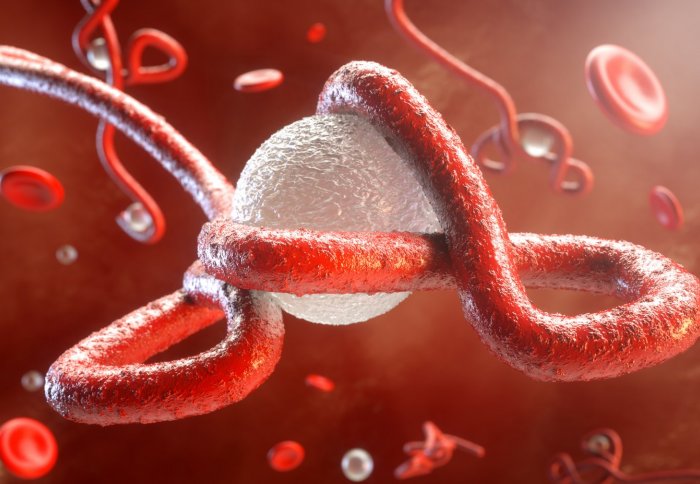
Ebola virus with an immune cell.

A prototype device for gauging patients' immunity to Ebola has been developed by a multi-institutional team of experts led by Imperial College London.
The device, which was developed in collaboration with UCL, works in a similar way to a pregnancy test. However instead of detecting hormones, it looks for an antibody called Immunoglobulin G (IgG), which is released following exposure to certain viruses.
We see great potential in this approach to help combat future Ebola outbreaks.
– Professor Molly Stevens
Deputy Director of i-sense
So far the biosensor has undergone a pilot trial under laboratory conditions, as well as in Uganda, where it was used to analyse blood serum from survivors previously exposed to the Ebola virus. In the trial the test was able to detect IgG antibodies from samples in around 15 minutes, compared to around five hours using conventional lab-based equipment.
The device is portable and connected to a smartphone so that the user can see the results on-screen, in the field. Being connected to a smartphone also means that its in-built navigation technology can be utilised to track the spread of an outbreak, which is important for disease surveillance and control.
The researchers say the technology requires optimisation and further study. However, they believe it shows promise as a rapid response tool for treating patients with Ebola, especially in remote areas of developing countries, where access to medical care is limited.
A biosensory breakthrough?
Professor Molly Stevens, Deputy Director of the “i-sense” Interdisciplinary Research Collaboration from Imperial’s Departments of both Materials and Bioengineering, said: “We’ve designed this biosensor to be highly effective at the point of care for a range of diseases. We see great potential in this approach to help combat future Ebola outbreaks.”

The device detects antibodies, like those shown here (in blue).
The tool contains proteins that bind to IgG when it is present. Upon binding, the proteins release a dye and stain the reader, much like how a pregnancy test does in the presence of pregnancy hormones, by using a technique known as ELISA. The result, along with its geographical coordinates, is communicated to the smartphone device and stored in an electronic archive.
The team say identifying IgG antibodies might help healthcare workers to understand the effects of exposure to different strains of the Ebola virus. The device may also enable doctors to detect immunity levels in patients during the early stages of their recovery, and help to understand vulnerable people's vaccination needs.
The next step for the team will be to streamline the test so that it can analyse blood taken from a finger prick, so that the results can be given immediately.
“A Serological Point-of-Care Test for the Detection of IgG Antibodies against Ebola Virus in Human Survivors” by Polina Brangel, Ariel Sobarzo, Claudio Parolo, Benjamin S. Miller, Philip D. Howes, Sigal Gelkop, Julius J. Lutwama, John M. Dye, Rachel A. McKendry, Leslie Lobel, and Molly M. Stevens, published 5 January 2017 in ACS Nano.
Image credit (Ebola with immune cell): Crevis/Shutterstock.com
Image credit (antibodies): xrender/Shutterstock.com
Supporters

Article text (excluding photos or graphics) available under an Attribution-NonCommercial-ShareAlike Creative Commons license.
Photos and graphics subject to third party copyright used with permission or © Imperial College London.
Reporter

Caroline Brogan
Communications Division

Contact details
Email: press.office@imperial.ac.uk
Show all stories by this author




Leave a comment
Your comment may be published, displaying your name as you provide it, unless you request otherwise. Your contact details will never be published.